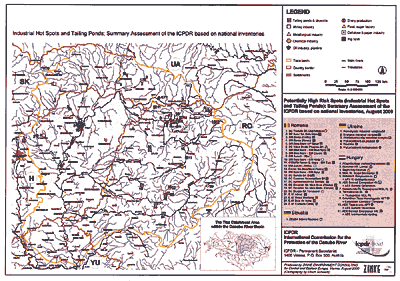On January 30, 2000, a tailings pond burst at an old-mining-tailings reprocessing facility of the Aurul SA Company in Baia Mare, Romania, leading to approximately 100,000 m³ of wastewater containing up to 120 tonnes of cyanide and heavy metals being released into the Lapus River. Six weeks later another tailings dam breached in Baia Borsa in the same region and 20,000 tonnes of heavy metal containing sediments were released into the Danube's tributaries.
Both accidents had serious impacts on the river environment killing most of the living organisms in the upper Tisza region. The impacts on the livelihoods in the fishing and tourism sectors were also serious. It was clear that urgent actions needed to be taken to identify, manage and reduce the environmental threat from abandoned tailings ponds and other accident risk spots. As a response, the 1st Regional Inventory of Potential Accident Risk Spots (ARS) in the Tisza catchment area of Romania, Hungary, Ukraine and Slovakia was made in July 2000. Later on, in September 2000, the ICPDR decided to prepare an ARS Inventory for the whole Danube River Basin. The Accident Emergency Prevention Warning System Expert Group (AEPWS EG) was given the responsibility for completing this task.
Since systems for classifying accident risk of industrial activities in the various countries of the Danube catchment area differ, authors of the ARS Inventory had to find a common procedure to be used for the classification. The approach taken by the International Commission for the Protection of the River Elbe (ICPE) was found to be the most suitable tool for the analysis of industrial activities with high accidental pollution risk in the Danube River Basin. This approach is based on a combination of the water-endangering potential expressed in terms of Water Risk Classes with the quantity of hazardous substances. Since the application of the Water Risk Classes also incorporates the substantial criteria used in the EU Seveso II directive and in the UN/ECE Industrial Accidents Convention, it was assured that all industrial installations subject to these regulations would be included in the ICPE approach. For the final assessment of a potential risk of an installation, the so-called Water Risk Index was used - a combination of Water Risk Classes and respective masses of hazardous substances handled and stored in an installation. The concept of Water Risk Index is comparable to the Richter scale for the assessment of earthquakes.
The ARS Inventory was completed in the summer of 2001. A total of 611 potential accidental risk spots in nine countries were reported. About 6 million tonnes of dangerous substances equivalent to the highest WRC 3 risk are handled and stored in these installations. However, it must be pointed out that the ARS survey was able only to give an indication of the potential hazards. The actual risks arising from the hazardous sites depend on the safety measures that have been applied in each installation. In order to estimate the real safety level that has been attained, special checklists have been developed based on the experience in combating accidental pollution in the Rhine and the Elbe rivers. In order to avoid more accidents similar to the one that occurred at Baia Mare, these checklists should be used by the authorities of the Danube countries in assessing the safety measures in each potential accident risk spot.
The Inventory of Potential Accident Risk Spots in the Danube River Basin is the first international review of the potentially dangerous installations in the Danube region. It is an important step towards the prevention of accidents in the Danube River Basin. However, if we are to maintain the highest safety standard for life in and on the Danube, the ARS Inventory must be considered as an ongoing activity with regular updates to ensure that no potential danger to the Danube remains concealed.
